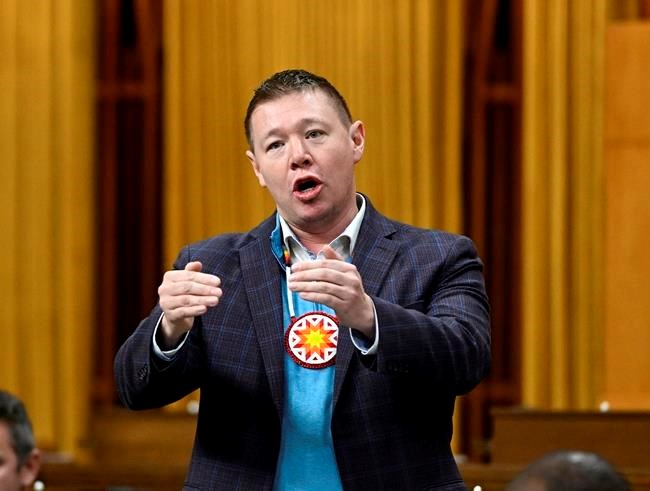OTTAWA — A Mi'kmaw member of Parliament said Tuesday that proposed changes to the boundaries of federal ridings in Nova Scotia would remove two Indigenous communities from the area he represents, including his home of Eskasoni First Nation.
The proposed change for Sydney-Victoria was done without the consultation of its Indigenous constituents, said Jaime Battiste, who lives on the reserve. He said that does nothing to help foster inclusion in politics.Â
"We're seeing that these boundaries are currently working to give Mi'kmaw people voices where they never had them before, for the first time in our history," Battiste said in an interview, referring to the existing electoral map.Â
"And the fact that they're changing things around, to me, it's very much looking at trying to reconstruct that glass ceiling that I broke when I was elected."
An independent commission tasked with redrawing the boundaries had focused on making Nova Scotia's 11 ridings more similar in population size, but critics say their method discounted Indigenous and racialized groups and the province's history.
The Electoral Boundaries Readjustment Act says about 88,000 people should live in each Nova Scotia riding, but the commission can depart from that target by 25 per cent to account for community interest, identity or history.Â
That means each riding could have no fewer than 66,095 people, and no more than 110,158 people.Â
Battiste lives in a riding that saw one of the largest population declines in Nova Scotia since the lines were last redrawn, but its current population would still fit within the rules.
He questioned the decision to remove two of the three Mi'kmaw First Nations that are within his riding, including his own large community.Â
"It seems rather strange, and rather peculiar, that out of an entire riding, the only place that is removed is the largest Mi'kmaw community," he said.
Other Liberal MPs from Nova Scotia, including Immigration Minister Sean Fraser and Lena Metlege Diab, raised concerns that the new boundaries could also divide other communities of racialized Nova Scotians.Â
The three testified on Tuesday at the House of Commons procedure and House affairs committee, which is studying the proposed new electoral boundaries.Â
Another proposed change for Halifax West would see a diverse part of the community removed from the urban riding, Diab said.
In its report, the commission acknowledged the concerns, saying it received "a significant volume of telephone and email inquires" about their proposals, but that "people don't like change" and there's "a strong sense of history in the province."
"There is a clear desire, especially in rural areas, to have particular counties remain together in the same electoral districts 'as they have since Confederation'," the report says.Â
The report also pointed out that residents were confused about the consultation process, but it left out any mention of Indigenous Peoples.Â
Last year, the commission held nine hearings, including some in French and one held virtually, to hear from Nova Scotians.Â
However, the three Liberal MPs raised concerns that they didn't accommodate Indigenous people, immigrants, newcomers and other racialized groups.Â
Battiste said that most Mi'kmaq people live about 40 minutes away from where consultations were being held, many of them don't speak English and many didn't have transportation to get there.Â
He said the commission failed in their duty to consult, and that First Nation chiefs in Nova Scotia are considering escalating the issue to Federal Court.
"There's a reason why there's systemic racism embedded into the system, because (it's) not meant to accommodate Indigenous Peoples," Battiste told MPs during the committee meeting.Â
The MPs' objections are to be sent back to the commission for review.Â
Fraser said after the hearing that he wants the commission to re-engage with First Nations, Black communities and municipalities.Â
He said the commission's initial consultations were done in small rooms that couldn't fit everyone who wanted to attend, and on one occasion, the location was changed at the last minute.Â
"A clarity in process to allow people to fairly participate is really important. I hope they take the opportunity to re-engage impacted communities who raised objections so they can end up with a better result at the end of the day," Fraser said.Â
Despite the airing of objections, the final decision-making on redrawing federal ridings in each province lays solely with the provincial commission, whose members are appointed by the House of Commons Speaker.Â
In Nova Scotia, the commissioners include Louise Carbert and David Johnson, who are political science professors at Dalhousie University and Cape Breton University respectively.
A third commissioner for the province is Justice Cindy Bourgeois, who sits on the Nova Scotia Court of Appeal.Â
Any approved changes will take effect during a general election held after April 1, 2024, at the earliest.Â
This report by The Canadian Press was first published Jan. 31, 2023.
Mickey Djuric, The Canadian Press




